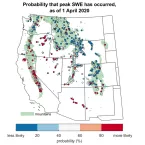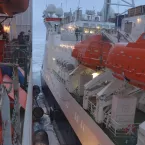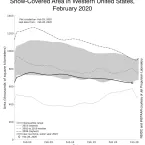Our Research
As climate changes, how do Earth's frozen areas affect our planet and impact society?
In this section
Related News & Stories
Filter by:
Analysis - Sea Ice Today
The pace of sea ice decline in April was near average, while sea ice extent ranked fourth lowest in the satellite record.

Analysis - Snow Today
April 1 is historically viewed as nearing the maximum Snow Water Equivalent (SWE). The Rockies show less than a 50 percent probability of reaching maximum SWE in March while the Sierra Nevada, Arizona, New Mexico...
Analysis - Sea Ice Today
After reaching its annual maximum on March 5, Arctic sea ice extent remained stable for several days before it started clearly declining. Continuing the pattern of this past winter, the Arctic Oscillation was in a persistently positive phase.

Feature Story
An advisee of National Snow and Ice Data Center (NSIDC) scientist Julienne Stroeve, Sean Horvath, a PhD candidate at the University of Colorado Boulder was one of twenty students chosen from six countries to take part in the Multidisciplinary drifting Observatory for the Study of Arctic Climate (MOSAiC) School. This is his experience.
Analysis - Sea Ice Today
Arctic sea ice appears to have reached its annual maximum extent on March 5.

Analysis - Snow Today
February continued to see a trend of below average snow cover across the Western United States. Late January and early February storms replenished snow cover in some areas, but drought continues to impact California.